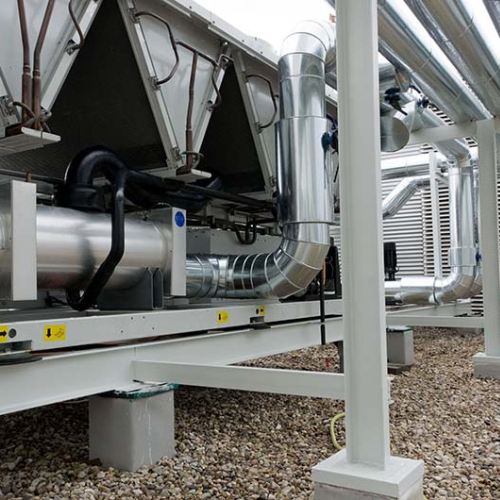
Chillers
Chillers are machines used to remove heat from a liquid via a vapor-compression or absorption refrigeration cycle. The chilled liquid is then circulated through a heat exchanger (often in an Air Handling Unit or Fan Coil Unit) to cool air or equipment in HVAC or industrial process cooling systems.
Incase of Queries, Feel Free To Reach Us At 042-35153686
Types of Chillers
Based on Cooling Method
Type | Description | Applications |
Air-Cooled Chiller | Uses ambient air to reject heat through fans and coils. No cooling tower required. | Smaller buildings, easier to install, suitable for hot climates |
Water-Cooled Chiller | Uses water and a cooling tower to reject heat. More efficient than air-cooled. | Large commercial/industrial buildings |
Evaporative-Cooled Chiller | Combines air and water cooling. | Hot, dry climates needing efficient cooling |
Based on Operation Principle
Type | Description |
Vapor Compression Chiller | Most common. Uses compressor, evaporator, condenser, and expansion valve. |
Absorption Chiller | Uses heat source (e.g., steam, gas) instead of compressor. Lower electrical usage. |
Key Components
Component | Function |
Compressor | Increases pressure & temperature of refrigerant |
Evaporator | Absorbs heat from chilled water loop |
Condenser | Rejects heat to air or water |
Expansion Valve | Drops refrigerant pressure to allow cooling |
Control Panel | Monitors and manages operation |
Chiller Performance Metrics
Metric | Description |
Cooling Capacity | Typically in Tons, kW, or BTU/hr (1 Ton = 3.5 kW ≈ 12,000 BTU/hr) |
COP (Coefficient of Performance) | Efficiency ratio (higher is better) |
EER / IPLV | Seasonal and part-load efficiency metrics |
Flow Rate | Chilled water flow (GPM or LPM) |
Set Point Temp. | Usually 6–12°C (43–55°F) outlet temp. |
Power Supply | Common: 400V / 480V, 3-phase |
Typical Applications
- HVAC Systems: For comfort cooling in offices, malls, hospitals
- Data Centers: Precision cooling
- Industrial Processes: Plastics, food processing, pharmaceuticals
- District Cooling Plants
Maintenance Requirements
Task | Frequency |
Filter cleaning | Monthly |
Water treatment | Ongoing (for water-cooled systems) |
Refrigerant level check | Monthly |
Oil analysis (compressors) | Quarterly |
Heat exchanger cleaning | Biannually or annually |
